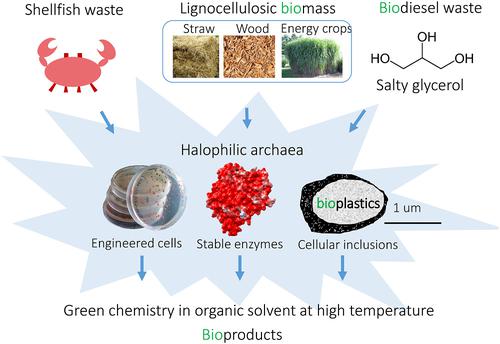当前位置:
X-MOL 学术
›
Biotechnol. Bioeng.
›
论文详情
Our official English website, www.x-mol.net, welcomes your
feedback! (Note: you will need to create a separate account there.)
Halophilic archaea and their potential to generate renewable fuels and chemicals
Biotechnology and Bioengineering ( IF 3.5 ) Pub Date : 2020-11-26 , DOI: 10.1002/bit.27639 Lakshmi Kasirajan 1, 2 , Julie A Maupin-Furlow 1, 3
Biotechnology and Bioengineering ( IF 3.5 ) Pub Date : 2020-11-26 , DOI: 10.1002/bit.27639 Lakshmi Kasirajan 1, 2 , Julie A Maupin-Furlow 1, 3
Affiliation

|
Lignocellulosic biofuels and chemicals have great potential to reduce our dependence on fossil fuels and mitigate air pollution by cutting down on greenhouse gas emissions. Chemical, thermal, and enzymatic processes are used to release the sugars from the lignocellulosic biomass for conversion to biofuels. These processes often operate at extreme pH conditions, high salt concentrations, and/or high temperature. These harsh treatments add to the cost of the biofuels, as most known biocatalysts do not operate under these conditions. To increase the economic feasibility of biofuel production, microorganisms that thrive in extreme conditions are considered as ideal resources to generate biofuels and value‐added products. Halophilic archaea (haloarchaea) are isolated from hypersaline ecosystems with high salt concentrations approaching saturation (1.5–5 M salt concentration) including environments with extremes in pH and/or temperature. The unique traits of haloarchaea and their enzymes that enable them to sustain catalytic activity in these environments make them attractive resources for use in bioconversion processes that must occur across a wide range of industrial conditions. Biocatalysts (enzymes) derived from haloarchaea occupy a unique niche in organic solvent, salt‐based, and detergent industries. This review focuses on the use of haloarchaea and their enzymes to develop and improve biofuel production. The review also highlights how haloarchaea produce value‐added products, such as antibiotics, carotenoids, and bioplastic precursors, and can do so using feedstocks considered “too salty” for most microbial processes including wastes from the olive‐mill, shell fish, and biodiesel industries.
中文翻译:

嗜盐古菌及其产生可再生燃料和化学品的潜力
木质纤维素生物燃料和化学品在减少我们对化石燃料的依赖和通过减少温室气体排放来减轻空气污染方面具有巨大潜力。化学、热和酶促过程用于从木质纤维素生物质中释放糖以转化为生物燃料。这些过程通常在极端 pH 条件、高盐浓度和/或高温下运行。这些苛刻的处理增加了生物燃料的成本,因为大多数已知的生物催化剂不能在这些条件下运行。为了提高生物燃料生产的经济可行性,在极端条件下茁壮成长的微生物被认为是生产生物燃料和增值产品的理想资源。嗜盐古菌(haloarchaea)是从高盐浓度接近饱和的高盐生态系统中分离出来的(1. 5–5 M 盐浓度),包括具有极端 pH 值和/或温度的环境。卤古菌及其酶的独特特性使它们能够在这些环境中维持催化活性,使其成为具有吸引力的资源,可用于必须在各种工业条件下发生的生物转化过程。源自卤代古细菌的生物催化剂(酶)在有机溶剂、盐基和洗涤剂行业中占有独特的地位。这篇综述的重点是使用卤古菌及其酶来开发和改进生物燃料的生产。该评论还强调了盐古菌如何生产增值产品,例如抗生素、类胡萝卜素和生物塑料前体,并且可以使用被认为对大多数微生物过程来说“太咸”的原料,包括橄榄磨坊的废物、贝类、
更新日期:2020-11-26
中文翻译:

嗜盐古菌及其产生可再生燃料和化学品的潜力
木质纤维素生物燃料和化学品在减少我们对化石燃料的依赖和通过减少温室气体排放来减轻空气污染方面具有巨大潜力。化学、热和酶促过程用于从木质纤维素生物质中释放糖以转化为生物燃料。这些过程通常在极端 pH 条件、高盐浓度和/或高温下运行。这些苛刻的处理增加了生物燃料的成本,因为大多数已知的生物催化剂不能在这些条件下运行。为了提高生物燃料生产的经济可行性,在极端条件下茁壮成长的微生物被认为是生产生物燃料和增值产品的理想资源。嗜盐古菌(haloarchaea)是从高盐浓度接近饱和的高盐生态系统中分离出来的(1. 5–5 M 盐浓度),包括具有极端 pH 值和/或温度的环境。卤古菌及其酶的独特特性使它们能够在这些环境中维持催化活性,使其成为具有吸引力的资源,可用于必须在各种工业条件下发生的生物转化过程。源自卤代古细菌的生物催化剂(酶)在有机溶剂、盐基和洗涤剂行业中占有独特的地位。这篇综述的重点是使用卤古菌及其酶来开发和改进生物燃料的生产。该评论还强调了盐古菌如何生产增值产品,例如抗生素、类胡萝卜素和生物塑料前体,并且可以使用被认为对大多数微生物过程来说“太咸”的原料,包括橄榄磨坊的废物、贝类、











































 京公网安备 11010802027423号
京公网安备 11010802027423号